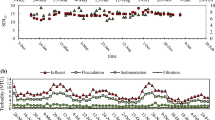Abstract
The article presents the results of a computational and analytical study of hybrid reverse osmosis–membrane distillation (RO–MD) technologies for desalination of Caspian Sea water, suggesting the production of an additional amount of desalinated water by the MD method from RO concentrates heated to 50–80°C by the waste heat of boiler-fuel combustion products. Two options for solving the problem of the CaCO3 and CaSO4 scaling of membranes have been studied: with preliminary nanofiltration (NF) or sodium cationization (Na) of seawater, as an alternative to the use of an antiscalant (AS) or acid. The negative environmental effect of most plants (eutrophication of water bodies) and their low efficiency at high concentrations of desalinated water are taken into account. The Langelier saturation index (СаСО3) and the degree of concentrate saturation (СаSO4) were used as criteria for membrane scaling. The NF and RO processes were studied using the computer program ROSA, and the MD and Na processes were studied by computer simulation of the corresponding design models. It has been found that at a 70% permeate yield at the NF and RO stages, the possibility of calcium scale deposition on the RO and MD membranes is excluded, but it can occur on NF membranes, thereby requiring the use of antiscalants. At the same time, the additional production of permeate at the MD stage from RO concentrates reaches 40% of the amount of permeate at the RO stage and the total power consumption according to the scheme is 1.88 kWh/m3. Reducing the calcium hardness of sea water to 50 µeq/dm3 by Na cationization makes it possible to refuse both the use of AS and sulfuric acid acidification with additional production of MD permeate of 27% relative to the RO permeate. The power consumption rises to 2.5 kW h/m3. To employ the known advantages of NF without the use of AS, a hybrid Na–NF–RO–MD scheme is proposed. It has been established that at 80% yields of NF and RO permeates, it is sufficient to reduce the hardness of sea water from 16 to 5.5 meq/dm3 to prevent CaSO4 scaling at all stages of treatment and to exclude CaCO3 scaling by acidifying the softened water.






Similar content being viewed by others
REFERENCES
D. Curto, V. Franzita, and A. Guercio, Appl. Sci. 11, 670 (2021).
S. G. Salinas-Rodríguez, J. C. Schippers, G. L. Amy, I. S. Kim, and M. D. Kennedy, Seawater Reverse Osmosis Desalination. Assessment and Pre-Treatment of Fouling and Scaling (IWA Publishing, London, 2021).
M. M. Elmesmary, et al., Int. J. Eng. Res. Appl. 7, 41 (2017).
P. Biniaz, et al., Chem. Eng. 3, 8 (2019).
D. Gonzales, et al., Renew. Sustain. Energy Rev. 80, 237 (2017).
A. A. Kiss and O. M. Kattan Readi, J. Chem. Technol. Biotechnol. 93, 2047 (2018).
J. Waritha, et al., Chem. Eng. Res. Des. 128, 15 (2017).
M. Feiner, et al., Environ. Pollut. 197, 309 (2015).
K. Popov, et al., Adv. Mater. Sci. Eng. 2016, 7635329 (2016).
A. A. Panteleev, B. E. Ryabchikov, and O. V. Khoruzhii, Membrane Separation Technologies in Industrial Water Treatment (DeLi plyus, Moscow, 2012) [in Russian].
Dong Zou, et al., J. Desalin. 376, 109 (2015).
A. Bassel, et al., Arabian J. Sci. Eng. 43, 4413 (2000).
G. K. Feiziev, Highly Efficient Methods of Water Softening, Desalination, and Desalination (Takhsil, Baku, 2009) [in Russian].
F. N. Karelin, Water Desalination by Reverse Osmosis (Stroiizdat, Moscow, 1988) [in Russian].
M. Futterlieb, et al., Chem. Ing. Tech. 9, 1359 (2021).
H. Jouhare, et al., Therm. Sci. Eng. Prog. 6, 268 (2018).
www.rosa9.software.informer.com.
S. P. Rudobashta and S. Yu. Makhmud, Khim. Khim. Prom. 55, 100 (2012).
A. Khalifa, et al., Desalination 404, 22 (2017).
Author information
Authors and Affiliations
Corresponding author
Ethics declarations
The author declares no conflicts of interest.
Additional information
Translated by S. Zatonsky
Rights and permissions
About this article
Cite this article
Ahmadova, J.A. Hybrid Seawater Desalination Technology Based on Reverse Osmosis and Membrane Distillation Methods. Membr. Membr. Technol. 5, 80–91 (2023). https://doi.org/10.1134/S2517751623020026
Received:
Revised:
Accepted:
Published:
Issue Date:
DOI: https://doi.org/10.1134/S2517751623020026




